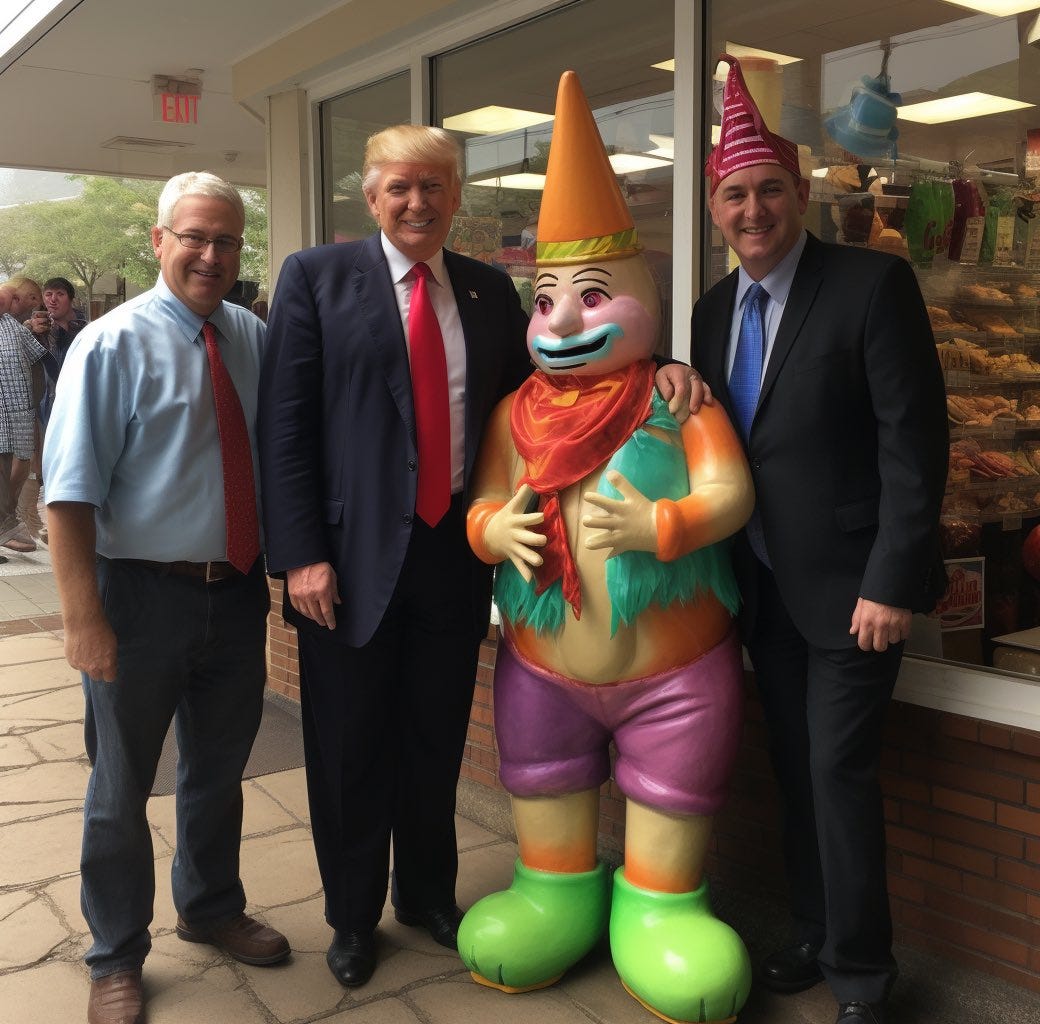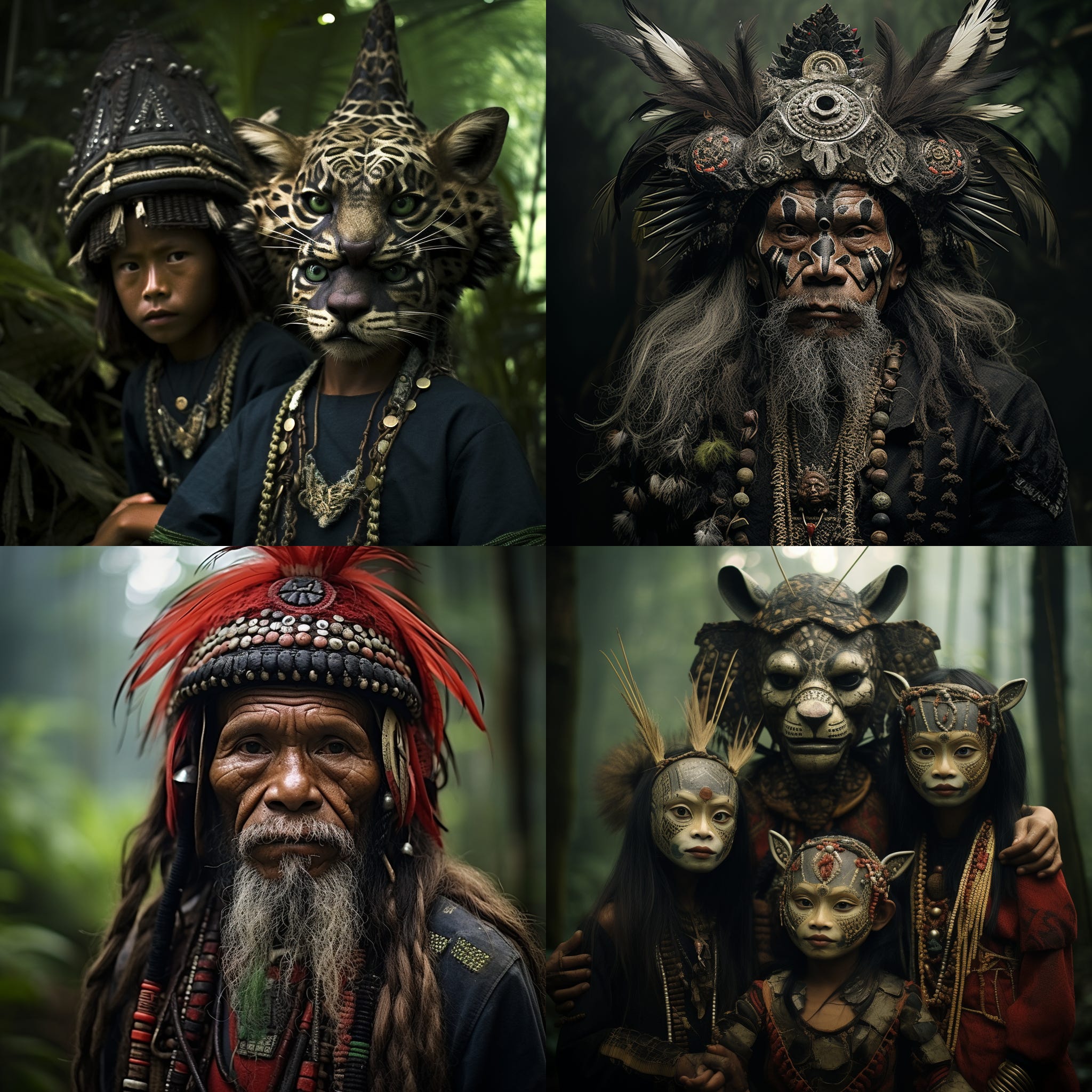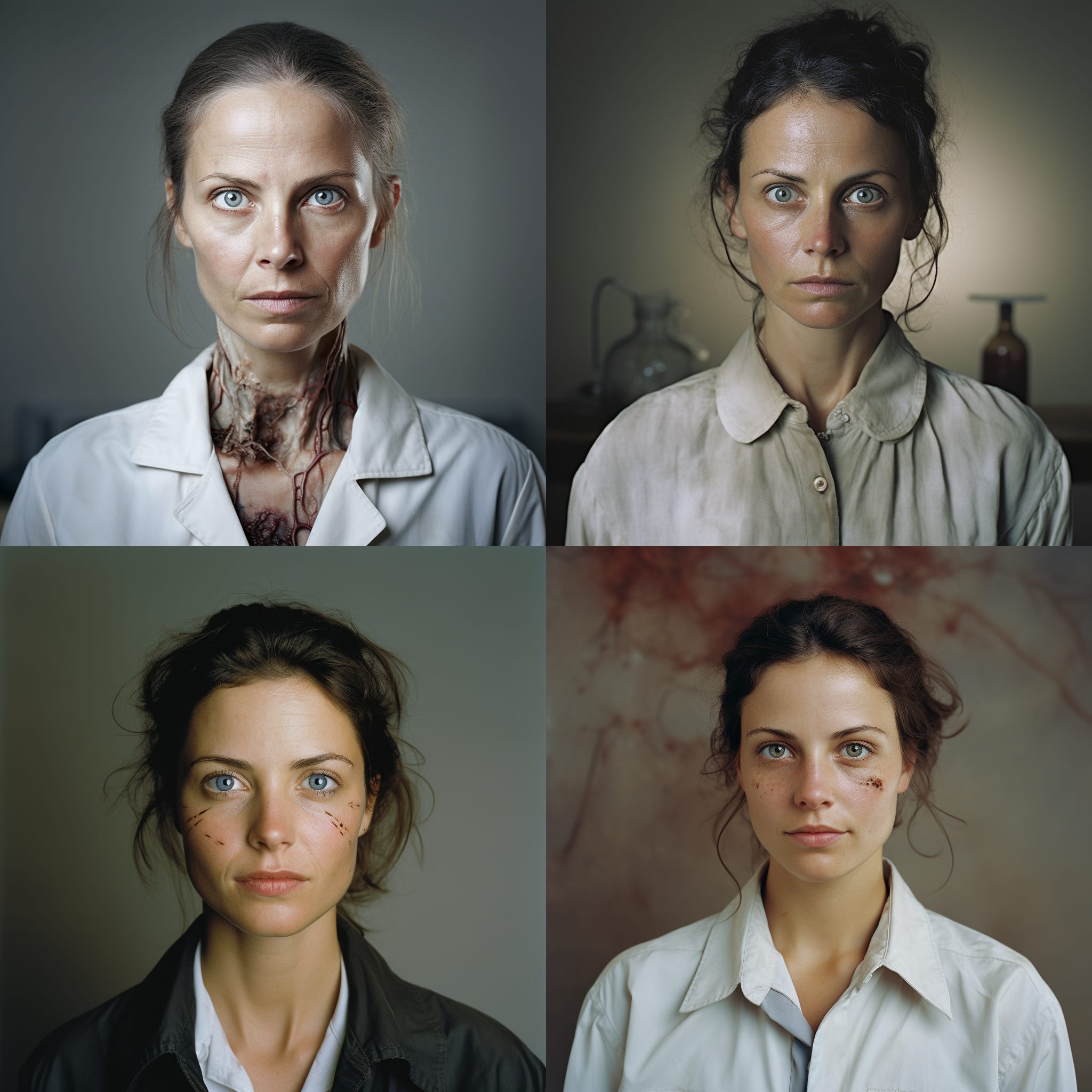How Midjourney Reads a Mugshot
The Algorithmic Hauntology of Sumatraist Aurorapunk

First off: Thanks, so much, to everyone who upgraded to a paid subscription after my request two weeks ago. It means a lot, and I am feeling highly motivated and grateful. You are all good folks. Sincerely: thank you!
If you’d like to subscribe but haven’t, you can support my work
for $1/month or $10/year with the button below by September 1. Thanks!
Donald Trump’s mugshot is fit for this moment of generative photography. Trump and generative AI are similarly aligned to visual media and internet metrics. Both generate images highly calibrated by media signals and internet metrics: a culmination of feedback loops between pictures on TV and his social media audience.
Trump is also famously noisy. In generative AI (GAI), noise also functions as a raw slate onto which many possibilities can be grafted. For Trump, QAnon was the most obvious example. Searching for patterns in noise, and finding stochastic resonances that feel meaningful, seemed to define responses to his presidency in the same way they define responses to a Diffusion model.
Trump Generation

The first mugshot of Trump’s four indictments was made public after Trump turned himself in to authorities in Georgia. The image has a whiff of surreality, just as anything unprecedented can first seem unreal. It also had none of the hallmarks of what we might expect from a mug shot, none of the cliches of a height bar or holding a sign with his name on it.
If you wanted to create a mugshot using generative AI (GAI), the data beneath this image couldn’t have created this one. GAI can only recombine a collective consensus into an imagined reproduction of that socially constructed reality. It weighs the most common occurrences in order to produce more of them.
Midjourney’s “/describe,” function is a helpful tool for seeing how these systems see. Upload an image, and “/describe” will tell you what prompt would produce it. You can use actual images, too, and see the same thing: a rough (but not precise) map for how it might label and categorize aspects of that image. Midjourney looks at the data in the image and connects elements of its visual information to text descriptors.
Here are four prompts that Midjourney believes would generate the actual Trump mugshot, shown above. Beneath each of these suggested prompts is an image that resulted from that prompt. In essence, we can visualize the difference between reality and the model.
This is how Midjourney reads Trump’s mugshot.
Mugshot Description 1
Description:
“donald trump is mugshot as seen, in the style of raw and confrontational, smooth and shiny, light gold and white, sumatraism, silver and pink, demonic photograph, asymmetry.”
Result of running that prompt through Midjourney:

Mugshot Description 2
Description:
“donald trump's mugshot is being photographed, in the style of light gold and pink, sumatraism, associated press photo, peter smeeth, mike mayhew, cobra, tamron sp 70-200mm f/2.8 di vc usd g2.”
Result of running that prompt through Midjourney:

Mugshot Description 3
Description:
“donald trump in mugshot video, in the style of tamron sp 70-200mm f/2.8 di vc usd g2, light beige and silver, cobra, associated press photo, dynamic chaos, aurorapunk, symmetrical asymmetry.”
Result of running that prompt through Midjourney:

Mugshot Description 4
Description:
“donald trump was in montgomery county on may 29th a, in the style of sumatraism, made of glass, associated press photo, clovis trouille, arthur wardle, david tindle, crisp and clean look.”
Result of running that prompt through Midjourney:

A Brief Exploration of Sumatraism
From here, I’m less interested in what Midjourney tells us about Donald Trump’s mugshot, and more interested in what Donald Trump’s mugshot tells us about Midjourney.
Specifically, the recurring occurance of “Sumatraism” in these suggestions, and the emergence of these types of genres in GAI image categories.
Sumatraism on its own produces a kind of hyperexoticized visualization of Sumatra / Indonesia: alone, the prompt brings up heavily stereotypical imagery associated with “Tiki bars” and other generalizations about the cultures of the islands of Southeast Asia.
Sumatraism has another connotation, too. It was an avant-garde movement created by the Serbian poet Miloš Crnjanski in the 1920s. Crnjanski’s poem, “Sumatra,” is a bit like Toto’s Africa, in that it is a longing for a place that the author has only ever imagined being. For Crnjanski, Sumatra is an exoticized paradise, far from the crumbling Europe he encountered after the first World War.
In an essay by Miro Masek, Sumatraism is defined as "the unity of various textual elements and various levels of structure, the harmony of form and ideas, motifs and rhythms, images and sounds, and the combination of everything with everything else."
Sumatraism is both a stereotypical representation of a world one has not experienced, and an apt description of the process of combining those stereotypes into novel combinations. Taking both of these together, the phrase accurately describes the entire process of organizing information in order to produce a picture.
I won’t give much credence to Sumatraism here, because it’s just one genre of style markers that make an image. We see these things in Midjourney’s text descriptions a lot, even here: “aurorapunk,” for example. There is a prevalence of “-punk,” “-core,” and “-ism” words in Midjourney’s prompt recommendations, and a lot of uncertainty about what they do.
We can look at sample images for a few of them.
Here are four images generated with “Sumatraism,” on its own. They are notable, to human viewers, for their reductive appropriation of South Asian stereotypes.

What is fascinating — and disturbing, to me — is that the “Sumatraism” prompt obviously creates an imaginary representation of Sumatran people, but also that this is, in the scheme of “genre,” secondary to the actual function of “Sumatraism” when it is suggested as a prompt.
At first glance it is absurd to connect these images to Donald Trump.
What these images have in common is not the presence of imaginary Sumatrans, but rather, a set of lighting and color effects. In theory, the kinds of images associated with these stereotypes of South East Asia are often created with a consistent set of style signifiers. Such “exotic” images of rainforests and tropical areas must often be represented with deep saturation, rich blacks and shadows in the underlying datasets. You can search popular image sharing websites and see for yourself.
If we remove sumatraism from the same mug shot prompts, it brightens the image. Here is the same prompt used for description 2, but I have removed Sumatraism and asked Midjourney to produce whatever the opposite of Sumatraism is.

Shadows are absent; colors less rich, and the images of Trump are less accurate.
Much of the prompts that people use to get images for these systems do less than many artists think. When writing prompts, people tend to think of subjects, and then specific constellations around those subjects: if we use a specific camera lens, we might choose matching lighting.
Midjourney sees things differently. Clusters of image information are bundled together and assigned to a category.
Sumatraism seems to combine a set of styles that includes facial expressions and color palettes. What is striking is that these aesthetics are also deeply associated with exoticized caricatures of Indonesian people. Those caricatures — the facial features, the head pieces, etc — are just another part of a genre category, and can be drawn out to make even Donald Trump’s face more accurate.
This clustering of aesthetic information and stereotypes is at the heart of AI image generation systems. This is true whether we are asking for pictures of flowers (a generalization of all flowers) or butterflies (a generalization, a stereotype, of all butterflies.) But it raises unique questions about removing harmful representational biases. How do you remove real Sumatrans from Sumatraism?
Another Experiment
Here’s one more experiment.
The first image is a baseline: I asked Midjourney to include zero style information, to create a blank expression, and a plain background. The woman is traditionally beautiful, as are most GAI faces, because composites tend to remove asymmetries that we find unappealing.

I then asked for variations on this image, using “Sumatraism” and “Zombiecore” as additional prompt keywords.

Obviously, Zombiecore draws on stereotypes, or tropes, associated with Zombie films. The woman is changed to reflect changes of genre. We see lab coats, skin alterations, blood spatter: as if in a zombie flick. All of this is represented with a single word: Zombiecore taps on a constellation of aesthetic effects.
Here’s what happens to the original image when we simply add the keyword Sumatraism.

Instead of being changed into Zombie tropes, the woman is now given the accoutrements of “colonial adventure,” if not outright transformed into the image of the “exotic” East Asian subject. The plain background becomes wooden panels. The lighting is harsher, faces sweatier. We see a nun, likely associated with missionary work.
We might say the “genre” of these style markers are haunted by images of similarly associated ideas. A category of information containing a set of harmless style effects can, it seems, contain residues of whatever those lingering tropes were used to depict.
Algorithmic Hauntology
In reversing images into prompts, it’s challenging to see the connections. Prompts influence images in mildly human-detectable ways. Trump’s Sumatraism mugshots lack that prompt’s saturation, deep blacks, and Southeast Asian caricatures. Remove the keyword, and the image is brighter — and less accurate to Trump.
Details that a human might see as key parts of an image, like the star in the left hand corner, or the decentering of the subject, are not what the machine prioritizes. It sorts everything into two categories: subjects, and vibes. Vibes are echoes: something hovering in the present from the past, felt but not fully present or graspable.
Mark Fisher pointed out that Sonic Hauntology was present when artists used samples in ways that highlighted their disintegration: think Tricky, or Portishead, or The Caretaker. The effects of time, and distortion of memory, brings a new reading of the archives. But it’s limited: a reanimation of what is gone, steeped in the illusion of liveliness.
Algorithmic Hauntology is much more dangerous. The real-world impacts of automated pattern analysis are rooted in archives, and mediated by the technologies that deliver them. It offers a simulation of attention to the present, and prediction of the future. But in fact, this is seance as politics, a conversation dominated by ghosts & residues of the past.
Predictive AI serves to govern us based on the past: a "hauntocracy.” Drawing on past failures, companies build surveillance systems haunted by racist imaginations. Our art is haunted by categories and ideals assigned by flawed historic archives. Algorithms act as spirits, activated and set loose to run things in ways that skew toward a disappearing past's vision of the present, and constrain new orientations toward the future.
We can use the past to create a living language. But it takes attention, and intention, to sift that past. It means dialogue with the living, and a respectful relationship with ghosts.
Learning to read algorithmic “vibes” in the absence of concrete explanations is a lot like listening to music. But the ghost playing the piano has an inherently retrograde ideological agenda. You don’t wanna catch that vibe.
Other Things I Did This Week
If this wasn’t enough to read, I have a piece up over at Tech Policy Press this week. It’s about the limits of looking at generative AI through the lens of copyright, and the opportunity to engage with data rights in the visual and textual art space. Check it out if that’s your thing!
Thanks for reading! Please share this post if you found it good, and encourage others to subscribe, too!





